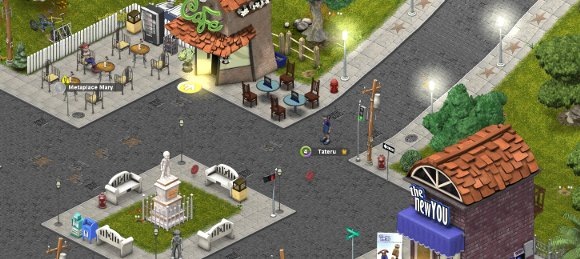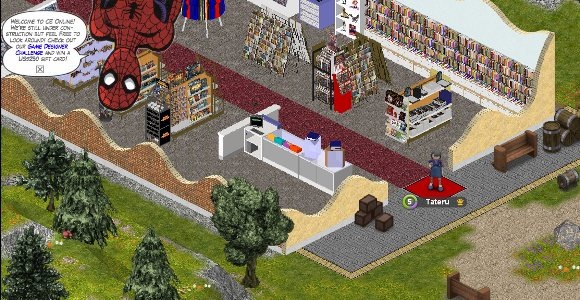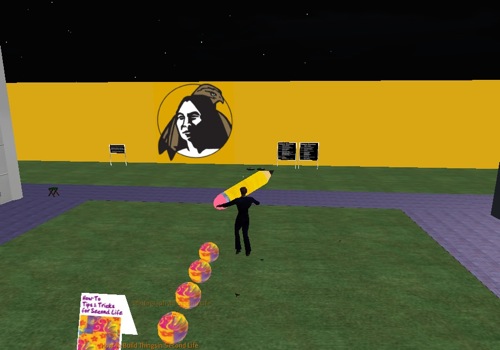Although originally billed as being for teenage girls, the Frenzoo concept has proven to be of interest to a much wider audience. Even though it’s early days yet, the site still being in beta, there’s already a thriving community of folks participating in Frenzoo, with a wide range of ages and nationalities, and both genders, being strongly represented.
What is Frenzoo about? Primarily, it’s about sharing style – not just "high fashion" or "mainstream" style, but whatever takes your fancy; as long as you stay within the terms of service, and your images fit into the PG category, your style will be celebrated by the Frenzoo community.
Ztylist
Your Ztylist is your avatar in Frenzoo. In addition to personalising their face, there’s a wide range of beauty products, hairstyles, clothing and accessories to choose from to create the look you desire for your avatar. Once you have chosen your Ztylist’s look, you can also alter the way they move (their Pose), and change the way their background (Home) looks. The Pose is a looped animation; you can easily choose when in the sequence to take an image (Snapshot) to get the effect you are after.
Shop
One of the ways to achieve your personal look is to shop for items. Clothing, hair and accessories are made by the Frenzoo team, and also by VIPs, who are able to create items to stock their shops with. Though currently somewhat limited in range, the number of items is growing daily, and the range of styles covered also continues to expand. Right now, only Frenzoo team members have the ability to create make-up, though they are always open to suggestions as to what they should add to the collection next.
Create
Of course, if the shop doesn’t carry just the item you desire, you can always make your own. Making personalised garments, shoes and accessories is a snap with the item creation tools supplied. There’s a stage for cutting, for making the pattern for the fabric, and for adding details like buckles, pockets and gems. Simple items can be done very rapidly – more complicated items take more fiddling and more time, but are eminently possible. The original shape of your item is determined by the template you choose initially: a ball-gown cannot be cut to make jeans, but jeans can easily be cut down to make shorts.
Right now, VIP status is gained by demonstrating your capability and interest to the Frenzoo team – look in the Frenzoo forums for the appropriate information.

The Zoo
Under the Zoo tab, you can get a quick overview of what other people’s Ztylists are wearing, and you have a quick link to their profile pages. Also under the Zoo tab are the Clubs, which are a great way to meet and communicate with people who have the same interests as you.
Shows
Shows are a fun and entertaining way to share your outfit creation and compilation abilities! It’s also a good place to make new friends. Each show has a theme; past themes have included Barbie, Emo and Cosplay (Superheroes, in this case). The idea is that you dress according to the theme, and then everyone gets a chance to vote for their favourite outfit. To keep things fair, the Frenzoo team has ensured that you can’t vote for yourself, and asks that you not spam people asking for their votes!
Share
Frenzoo has made it easy to share around the Frenzoo love – there are a wide range of banners and logos available to place on other web sites, and it’s also easy to place snapshots of your Ztylist on blogs, Myspace, and other similar places.
Forum
The Frenzoo forum is essentially like any other forum – it contains useful information about the site, alerts users to upcoming shows and changes to Frenzoo, and is a great place to carry on conversations with other users in the community. Moderation is in place to keep the atmosphere friendly and safe – if you wouldn’t say it to a 13 year old, don’t say it here.
Verdict
Frenzoo is a nifty piece of work, and there are more improvements to come. It may or may not be attractive to you now, but be aware that there are many changes in the pipeline – and one or more of those might make the difference that gets you intrigued.



 Views of spaces can be customized, UI widgets can be added. There’s a great deal of support for building game-spaces, and if I were able to spare the time for making a game, Metaplace is definitely where I’d want to be doing it.
Views of spaces can be customized, UI widgets can be added. There’s a great deal of support for building game-spaces, and if I were able to spare the time for making a game, Metaplace is definitely where I’d want to be doing it.


 1. Linden Lab are excited about the take-up of voice in Second Life, stating more than 15 billion minutes of voice
1. Linden Lab are excited about the take-up of voice in Second Life, stating more than 15 billion minutes of voice  There’s a great story over on
There’s a great story over on
Recent Comments